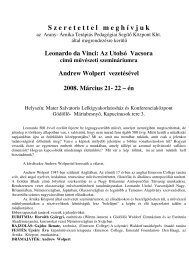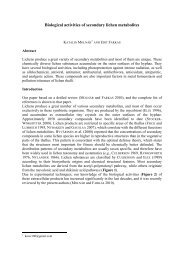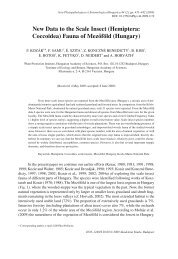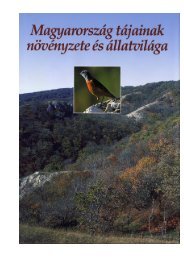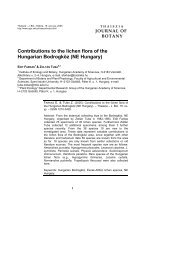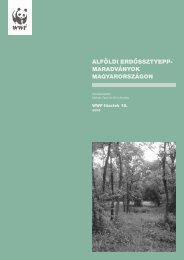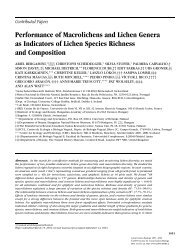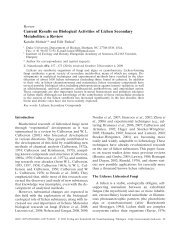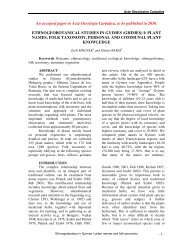Floodplain hay meadows along the river Tisza in Hungary
Floodplain hay meadows along the river Tisza in Hungary
Floodplain hay meadows along the river Tisza in Hungary
You also want an ePaper? Increase the reach of your titles
YUMPU automatically turns print PDFs into web optimized ePapers that Google loves.
extensive cattle farm<strong>in</strong>g, fish<strong>in</strong>g (e.g. of <strong>the</strong> traditional species “csík”<br />
(Barbatula spp.)), catch<strong>in</strong>g crabs and also by trad<strong>in</strong>g crops and livestock<br />
(Andrásfalvy, 2007; Frisnyák, 1990).<br />
In addition to <strong>the</strong> local farm<strong>in</strong>g system, transhumance also existed.<br />
In <strong>the</strong> process of extensive livestock farm<strong>in</strong>g, <strong>the</strong> grey cattle were<br />
driven from <strong>the</strong> summer pastures to <strong>the</strong> w<strong>in</strong>ter pastures of <strong>the</strong><br />
floodpla<strong>in</strong>, which was covered by a more productive sward (Andrásfalvy,<br />
2007). Pigs, liv<strong>in</strong>g on <strong>the</strong> <strong>river</strong><strong>in</strong>e <strong>meadows</strong> and marshes dur<strong>in</strong>g<br />
summer like “semi-wild” boars, spent <strong>the</strong> w<strong>in</strong>ter <strong>in</strong> <strong>the</strong> vast oak<br />
woodlands of <strong>the</strong> upper reaches of <strong>the</strong> <strong>Tisza</strong>, where <strong>the</strong>y fattened<br />
on <strong>the</strong> acorns to reach <strong>the</strong>ir sell<strong>in</strong>g weight (Bellon, 2003). From <strong>the</strong><br />
neighbour<strong>in</strong>g mounta<strong>in</strong>s, large herds were also transferred to <strong>the</strong><br />
Great Pla<strong>in</strong> after <strong>the</strong> summer.<br />
At <strong>the</strong> beg<strong>in</strong>n<strong>in</strong>g of <strong>the</strong> 19 th century, <strong>the</strong> need for <strong>the</strong> expansion of<br />
arable land <strong>in</strong>creased as a result of <strong>the</strong> rise <strong>in</strong> crop prices and <strong>the</strong><br />
growth <strong>in</strong> population. This land was <strong>in</strong>itially obta<strong>in</strong>ed by <strong>the</strong> prevention<br />
of regular flood<strong>in</strong>g of <strong>the</strong> <strong>meadows</strong> and marshes. This led to<br />
<strong>the</strong> dry<strong>in</strong>g out and rapid sal<strong>in</strong>isation of <strong>meadows</strong> <strong>in</strong> many areas. The<br />
vast dra<strong>in</strong>ed marshes and fens were ploughed. A negative effect of<br />
keep<strong>in</strong>g <strong>the</strong> water out of <strong>the</strong>se fields was <strong>the</strong> <strong>in</strong>crease of <strong>the</strong> annual<br />
floods <strong>in</strong> <strong>the</strong> area close to <strong>the</strong> <strong>river</strong>.<br />
Build<strong>in</strong>g high levees<br />
Moreover, because of woodland clearance <strong>in</strong> <strong>the</strong> mounta<strong>in</strong>s catchments<br />
of <strong>the</strong> <strong>river</strong> bas<strong>in</strong>, <strong>the</strong> Great Pla<strong>in</strong> received a greater volume<br />
of water at a faster rate. To solve <strong>the</strong>se problems, high levees were<br />
built from 1884 onwards, with a f<strong>in</strong>al total length of 3000 km (Dunka<br />
et al., 1996). These embankments divided <strong>the</strong> floodpla<strong>in</strong> <strong>in</strong>to a “floodfree”<br />
area (<strong>in</strong>ner-dike area) and <strong>the</strong> “floodway”(outer-dike area),<br />
which is regularly <strong>in</strong>undated. Due to <strong>the</strong> levees be<strong>in</strong>g built close to<br />
<strong>the</strong> <strong>river</strong>bed and <strong>the</strong> isolation of <strong>the</strong> former <strong>meadows</strong> and marshes<br />
from <strong>river</strong> floods, numerous habitats became considerably degraded<br />
and, <strong>in</strong> addition, <strong>the</strong> biodiversity of <strong>the</strong>se regions also substantially<br />
decreased. Careless alteration of land use has led to <strong>the</strong> accumulation<br />
of seem<strong>in</strong>gly unsolvable economic and social problems (Mihók et al.,<br />
2006; Rakonczay, 2002). As a result of water management, common<br />
pastures had been parcelled by <strong>the</strong> end of <strong>the</strong> 19 th century and <strong>the</strong><br />
traditional transhumance <strong>in</strong> <strong>the</strong> floodpla<strong>in</strong> <strong>meadows</strong> also ceased. The<br />
extensive farm<strong>in</strong>g us<strong>in</strong>g <strong>the</strong> ancient grey cattle decl<strong>in</strong>ed significantly,<br />
and <strong>the</strong> “semi-wild” pig breeds also disappeared (Andrásfalvy, 2007).<br />
Fur<strong>the</strong>r dra<strong>in</strong><strong>in</strong>g and <strong>in</strong>tensification<br />
By <strong>the</strong> 1960’s, even <strong>the</strong> rema<strong>in</strong><strong>in</strong>g <strong>in</strong>land waters on previous floodpla<strong>in</strong>s<br />
beyond <strong>the</strong> levees had been dra<strong>in</strong>ed. The arid grasslands,<br />
hav<strong>in</strong>g replaced <strong>the</strong> dried-out <strong>meadows</strong>, had been mostly ploughed<br />
by that time. This situation was worsened with <strong>the</strong> <strong>in</strong>troduction of<br />
<strong>the</strong> s<strong>in</strong>gle-crop system established on vast fields, toge<strong>the</strong>r with <strong>the</strong><br />
<strong>in</strong>creased use of chemicals and fertilizers. The replacement of <strong>the</strong><br />
floodpla<strong>in</strong> <strong>meadows</strong> and native woodlands with plantations of alien<br />
species (hybrids of Populus canadensis, Frax<strong>in</strong>us pennsylvanica and<br />
Acer segundo) and <strong>the</strong> establishment of large-scale cultivation on<br />
<strong>the</strong> floodway also commenced at this time. However, an <strong>in</strong>terest<strong>in</strong>g<br />
dualism can be observed concern<strong>in</strong>g <strong>the</strong> utilisation of <strong>the</strong> floodway:<br />
on floodpla<strong>in</strong> <strong>meadows</strong> and pastures extensive, small-scale peasant<br />
farm<strong>in</strong>g (graz<strong>in</strong>g, mow<strong>in</strong>g, etc.) survived until <strong>the</strong> 1980’s, simultaneously<br />
with <strong>the</strong> socialist large-scale farm<strong>in</strong>g and forestry system. The<br />
reason was that woodlands and wooded <strong>hay</strong>fields smaller than 50<br />
ha were placed under <strong>the</strong> ownership of <strong>the</strong> farmers’ co-operatives<br />
<strong>in</strong>stead of forestry. Thus, <strong>the</strong>ir traditional, extensive utilisation may<br />
have played a significant role <strong>in</strong> <strong>the</strong> preservation of <strong>river</strong><strong>in</strong>e species<br />
and biodiversity.<br />
Although <strong>in</strong> <strong>the</strong> second half of <strong>the</strong> 20th century most floodpla<strong>in</strong><br />
<strong>meadows</strong> ly<strong>in</strong>g <strong>in</strong> <strong>the</strong> floodway were converted <strong>in</strong>to <strong>hay</strong>fields, grazed<br />
pastures also rema<strong>in</strong>ed until <strong>the</strong> 1980’s. The treeless grasslands, <strong>the</strong><br />
wooded pastures and <strong>hay</strong>fields and even <strong>the</strong> grass layer of <strong>the</strong> sparse<br />
woodlands, were grazed and mown. The graz<strong>in</strong>g and mow<strong>in</strong>g pattern<br />
of <strong>the</strong> grasslands was determ<strong>in</strong>ed by <strong>the</strong> diverse topography, <strong>the</strong><br />
water regime and <strong>the</strong> climatic conditions.<br />
Recent abandonment of <strong>the</strong> <strong>river</strong> valley<br />
In <strong>the</strong> early 1990’s <strong>the</strong> socio-economic changes (re-privatisation,<br />
decreased support for animal husbandry) considerably altered <strong>the</strong><br />
use of <strong>the</strong> floodway grasslands. Subsidisation of animal husbandry<br />
reached its m<strong>in</strong>imum level and as a consequence less milk, meat and<br />
wool was produced. S<strong>in</strong>ce <strong>the</strong> local market system had not been developed<br />
by that time due to <strong>the</strong> previous central control, <strong>the</strong> number<br />
of livestock dramatically and rapidly decreased <strong>in</strong> <strong>the</strong> settlements<br />
<strong>along</strong> <strong>the</strong> <strong>river</strong>. The management of <strong>the</strong> <strong>meadows</strong> and wooded pastures<br />
of <strong>the</strong> floodway ceased and this has resulted <strong>in</strong> <strong>the</strong> slow <strong>in</strong>vasion<br />
by shrubs, which is consistent with <strong>the</strong>ir orig<strong>in</strong> from woodland<br />
clearance. At <strong>the</strong> same time, toge<strong>the</strong>r with <strong>the</strong> abandonment of <strong>the</strong><br />
pastures, <strong>the</strong> cultivation of several arable fields also ceased, and<br />
<strong>the</strong>se areas were <strong>in</strong>vaded <strong>in</strong> a few years by <strong>the</strong> previously <strong>in</strong>troduced<br />
Amorpha fruticosa. The sudden <strong>in</strong>crease <strong>in</strong> <strong>the</strong> amount of propagules,<br />
toge<strong>the</strong>r with <strong>the</strong> high-level floods of <strong>the</strong> late 1990’s, led to <strong>the</strong> serious<br />
<strong>in</strong>festation of all <strong>the</strong> grasslands, wooded <strong>hay</strong>fields and woodlands.<br />
The swiftly spread<strong>in</strong>g Amorpha fruticosa destroys <strong>the</strong> natural<br />
vegetation by <strong>the</strong> deep shad<strong>in</strong>g of its dense population as well as by<br />
means of allelopathy (Szigetvári and Tóth, 2002). When <strong>the</strong> <strong>in</strong>dividuals<br />
<strong>in</strong>vad<strong>in</strong>g a certa<strong>in</strong> area reach <strong>the</strong> age of 4-5 years, <strong>the</strong>y form a<br />
closed canopy, and <strong>the</strong> grassland becomes featureless, <strong>the</strong> character<br />
species disappear, and only species resistant to shad<strong>in</strong>g can survive.<br />
The floodpla<strong>in</strong> <strong>hay</strong> <strong>meadows</strong> of <strong>the</strong> region<br />
Due to flood control, ancient floodpla<strong>in</strong> <strong>hay</strong> <strong>meadows</strong>, with a nearnatural<br />
water regime and water supply can only be found with<strong>in</strong> <strong>the</strong><br />
floodway of <strong>the</strong> <strong>river</strong> <strong>Tisza</strong>. <strong>Floodpla<strong>in</strong></strong> <strong>meadows</strong> ly<strong>in</strong>g beyond <strong>the</strong><br />
levees have been ei<strong>the</strong>r cultivated or have dried out, thus <strong>the</strong>y have<br />
become sal<strong>in</strong>ified and have changed <strong>in</strong>to Achillea steppes. Accord<strong>in</strong>g<br />
to recent studies, floodpla<strong>in</strong> <strong>meadows</strong> isolated from <strong>the</strong> <strong>river</strong> totally<br />
dry out and become sal<strong>in</strong>ised with<strong>in</strong> 50-60 years. They are replaced<br />
by dry, short grass-dom<strong>in</strong>ated steppes typically with Achilleo-Festucetum<br />
pseudov<strong>in</strong>ae vegetation (or Lythro-Alopecuraetum <strong>in</strong> regions of<br />
lower elevation), <strong>the</strong> soil of which accumulates alkali salts at depth<br />
(Molnár and Borhidi, 2003).<br />
In <strong>the</strong> Pleistocene and lower Holocene, <strong>the</strong> meander<strong>in</strong>g <strong>river</strong>s of <strong>the</strong><br />
Great Pla<strong>in</strong> deposited semi-circular po<strong>in</strong>t bars. These curved ridges<br />
can be observed on <strong>hay</strong> <strong>meadows</strong> anywhere <strong>in</strong> <strong>the</strong> floodpla<strong>in</strong> <strong>along</strong><br />
<strong>the</strong> <strong>Tisza</strong>. The narrow depressions between <strong>the</strong>se ridges, which support<br />
marshes and sedge-dom<strong>in</strong>ated communities, usually had a direct<br />
connection with <strong>the</strong> <strong>river</strong> <strong>in</strong> past centuries. Today, <strong>the</strong>se are covered<br />
by smaller or wider patches of marsh vegetation dom<strong>in</strong>ated by<br />
Glyceria maxima or Phalaris arund<strong>in</strong>acea large sedges such as Carex<br />
gracilis, and beds of Phragmites australis or Typha latifolia. The top of<br />
<strong>the</strong> curved ridges are covered by Peucedanum offic<strong>in</strong>ale dom<strong>in</strong>ated<br />
meadow-steppes, while on <strong>the</strong>ir slopes and at lower elevations, tall<br />
herb communities and different types of marshes have established.<br />
The <strong>meadows</strong> have properly adapted to <strong>the</strong> rapidly chang<strong>in</strong>g water<br />
supply and, with <strong>the</strong>ir dynamically chang<strong>in</strong>g species composition,<br />
<strong>the</strong>y tolerate both <strong>the</strong> longer humid and dry periods. Nowadays,<br />
<strong>the</strong>y are partially under nature conservation management, and <strong>the</strong><br />
authorities try to susta<strong>in</strong> <strong>the</strong>ir current state by mechanized mow<strong>in</strong>g.<br />
Under natural conditions, with <strong>the</strong> cessation of mow<strong>in</strong>g or graz<strong>in</strong>g,<br />
<strong>the</strong> floodpla<strong>in</strong> <strong>meadows</strong> are slowly encroached by <strong>the</strong> native <strong>river</strong><strong>in</strong>e<br />
trees (Salix alba, S. fragilis, S. purpurea, Populus alba, P. nigra, Quercus<br />
robur, Frax<strong>in</strong>us angustifolia ssp. pannonica, Ulmus campestris and U.<br />
laevis) or shrubs (Viburnum opulus, Euonymus europaeus, Sambucus<br />
nigra and Crataegus monogyna), as <strong>the</strong>y orig<strong>in</strong>ated from <strong>the</strong> cleared<br />
woodlands. This tendency was utilised by humank<strong>in</strong>d with <strong>the</strong> development<br />
of wooded pastures and <strong>hay</strong>fields, where some young trees<br />
were left to grow, establish<strong>in</strong>g a special landscape characteristic of<br />
<strong>the</strong> <strong>Tisza</strong> floodpla<strong>in</strong>. Due to <strong>the</strong> cessation of management, <strong>the</strong> condition<br />
of <strong>the</strong> wooded pastures and <strong>hay</strong>fields gradually decl<strong>in</strong>ed and<br />
<strong>the</strong>y are replaced by thickets of <strong>in</strong>troduced species over a relatively<br />
short period of time. Though <strong>the</strong>y have great value as examples of<br />
traditional land-use support<strong>in</strong>g high biodiversity, <strong>the</strong>ir preservation<br />
on <strong>the</strong> non-protected areas has not as yet been resolved.<br />
<strong>Floodpla<strong>in</strong></strong> mesotrophic <strong>meadows</strong><br />
<strong>Floodpla<strong>in</strong></strong> mesotrophic <strong>meadows</strong> were once <strong>the</strong> most frequent<br />
meadow type <strong>along</strong> <strong>the</strong> <strong>Tisza</strong>. Even today <strong>the</strong>y serve as a matrix for<br />
<strong>the</strong> floodpla<strong>in</strong> <strong>hay</strong> <strong>meadows</strong>. Under natural conditions, <strong>the</strong>y are wet<br />
dur<strong>in</strong>g <strong>the</strong> greater part of <strong>the</strong> year, and often <strong>in</strong>undated. They are<br />
characterised by meadow and marsh species and dom<strong>in</strong>ated by Alopecurus<br />
pratensis, Poa pratensis, Festuca pratensis, Dactylis glomerata<br />
and Carex melanostachya. The average height of <strong>the</strong> sward is about<br />
0,5-1 metre and species composition is determ<strong>in</strong>ed by <strong>the</strong> duration<br />
of water cover. The characteristic species are Clematis <strong>in</strong>tegrifolia,<br />
Galium rubioides, Cardam<strong>in</strong>e pratensis, Galega offic<strong>in</strong>alis, Gratiola offic<strong>in</strong>alis,<br />
Viola elatior, Rumex confertus, Thalictrum flavum, Thalictrum<br />
lucidum, Cirsium canum, Cichorium <strong>in</strong>tibus, Symphytum offic<strong>in</strong>ale, Iris<br />
pseudacorus, Galium palustre, Lysimachia vulgaris, Lythrum virgatum,<br />
L. salicaria, Ranunculus repens, Past<strong>in</strong>aca sativa and Lychnis flos-cucculi.<br />
Sometimes <strong>the</strong>y may have fen characteristics due to water logg<strong>in</strong>g.<br />
This is <strong>in</strong>dicated by <strong>the</strong> presence of species such as Serratula t<strong>in</strong>ctoria,<br />
Ophioglossum vulgatum and Gentiana pneumonan<strong>the</strong>. In <strong>the</strong> <strong>meadows</strong>,<br />
<strong>the</strong> characteristic colourful species <strong>in</strong>clude those that are often also<br />
typical of <strong>the</strong> willow-poplar woodlands, such as Leucojum aestivum.<br />
240<br />
241



